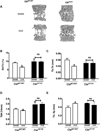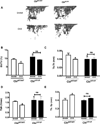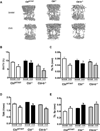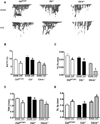Loss of Cbl-PI3K interaction in mice prevents significant bone loss following ovariectomy
- PMID: 24994594
- PMCID: PMC4149851
- DOI: 10.1016/j.bone.2014.06.013
Loss of Cbl-PI3K interaction in mice prevents significant bone loss following ovariectomy
Abstract
Cbl and Cbl-b are E3 ubiquitin ligases and adaptor proteins, which perform regulatory roles in bone remodeling. Cbl-/- mice have delayed bone development due to decreased osteoclast migration. Cbl-b-/- mice are osteopenic due to increased bone resorbing activity of osteoclasts. Unique to Cbl, but not present in Cbl-b, is tyrosine 737 in the YEAM motif, which upon phosphorylation provides a binding site for the regulatory p85 subunit of PI3K. Substitution of tyrosine 737 with phenylalanine (Y737F, CblYF/YF mice) prevents Y737 phosphorylation and abrogates the Cbl-PI3K interaction. We have previously reported that CblYF/YF mice had increased bone volume due to defective bone resorption and increased bone formation. Here we show that the lumbar vertebra from CblYF/YF mice did not have significant bone loss following ovariectomy. Our data also suggests that abrogation of Cbl-PI3K interaction in mice results in the loss of coupling between bone resorption and formation, since ovariectomized CblYF/YF mice did not show significant changes in serum levels of c-terminal telopeptide (CTX), whereas the serum levels of pro-collagen type-1 amino-terminal pro-peptide (P1NP) were decreased. In contrast, following ovariectomy, Cbl-/- and Cbl-b-/- mice showed significant bone loss in the tibiae and L2 vertebrae, concomitant with increased serum CTX and P1NP levels. These data indicate that while lack of Cbl or Cbl-b distinctly affects bone remodeling, only the loss of Cbl-PI3K interaction protects mice from significant bone loss following ovariectomy.
Keywords: Bone resorption; Cbl; Cbl-b; Osteoclast; Ovariectomy; PI3K.
Copyright © 2014 Elsevier Inc. All rights reserved.
Figures






Similar articles
-
Cbl-PI3K interaction regulates Cathepsin K secretion in osteoclasts.Bone. 2019 Oct;127:376-385. doi: 10.1016/j.bone.2019.07.009. Epub 2019 Jul 9. Bone. 2019. PMID: 31299383 Free PMC article.
-
Loss of Cbl-PI3K interaction enhances osteoclast survival due to p21-Ras mediated PI3K activation independent of Cbl-b.J Cell Biochem. 2014 Jul;115(7):1277-89. doi: 10.1002/jcb.24779. J Cell Biochem. 2014. PMID: 24470255 Free PMC article.
-
The loss of Cbl-phosphatidylinositol 3-kinase interaction perturbs RANKL-mediated signaling, inhibiting bone resorption and promoting osteoclast survival.J Biol Chem. 2010 Nov 19;285(47):36745-58. doi: 10.1074/jbc.M110.124628. Epub 2010 Sep 17. J Biol Chem. 2010. PMID: 20851882 Free PMC article.
-
Cbl-phosphatidylinositol 3 kinase interaction differentially regulates macrophage colony-stimulating factor-mediated osteoclast survival and cytoskeletal reorganization.Ann N Y Acad Sci. 2010 Mar;1192:376-84. doi: 10.1111/j.1749-6632.2009.05346.x. Ann N Y Acad Sci. 2010. PMID: 20392263 Review.
-
The Regulation of E3 Ubiquitin Ligases Cbl and its Cross-talking in Bone Homeostasis.Curr Stem Cell Res Ther. 2021;16(6):683-687. doi: 10.2174/1574888X15666200712191623. Curr Stem Cell Res Ther. 2021. PMID: 32652923 Review.
Cited by
-
Cbl-PI3K interaction regulates Cathepsin K secretion in osteoclasts.Bone. 2019 Oct;127:376-385. doi: 10.1016/j.bone.2019.07.009. Epub 2019 Jul 9. Bone. 2019. PMID: 31299383 Free PMC article.
-
PI3K activation increases SDF-1 production and number of osteoclast precursors, and enhances SDF-1-mediated osteoclast precursor migration.Bone Rep. 2019 Mar 22;10:100203. doi: 10.1016/j.bonr.2019.100203. eCollection 2019 Jun. Bone Rep. 2019. PMID: 30989092 Free PMC article.
-
Role of Cbl-PI3K Interaction during Skeletal Remodeling in a Murine Model of Bone Repair.PLoS One. 2015 Sep 22;10(9):e0138194. doi: 10.1371/journal.pone.0138194. eCollection 2015. PLoS One. 2015. PMID: 26393915 Free PMC article.
-
Tectorigenin inhibits RANKL-induced osteoclastogenesis via suppression of NF-κB signalling and decreases bone loss in ovariectomized C57BL/6.J Cell Mol Med. 2018 Oct;22(10):5121-5131. doi: 10.1111/jcmm.13801. Epub 2018 Jul 31. J Cell Mol Med. 2018. PMID: 30063119 Free PMC article.
-
Wnt-associated adult stem cell marker Lgr6 is required for osteogenesis and fracture healing.Bone. 2023 Apr;169:116681. doi: 10.1016/j.bone.2023.116681. Epub 2023 Jan 25. Bone. 2023. PMID: 36708855 Free PMC article.
References
-
- Turner RT. Mice, estrogen, and postmenopausal osteoporosis. Journal of bone and mineral research : the official journal of the American Society for Bone and Mineral Research. 1999;14:187–191. - PubMed
-
- Swaminathan G, Tsygankov AY. The Cbl family proteins: ring leaders in regulation of cell signaling. Journal of cellular physiology. 2006;209:21–43. - PubMed
-
- Thien CBF, Langdon WY. Cbl: many adaptations to regulate protein tyrosine kinases. Nat. Rev. Mol. Cell. Biol. 2001;2:294–305. - PubMed
-
- Naramura M, Jang I-K, Kole H, Huang F, Haines D, Gu H. c-Cbl and Cbl-b regulate T cell responsiveness by promoting ligand-induced TCR down-modulation. Nature immunology. 2002;3:1192–1199. - PubMed
Publication types
MeSH terms
Substances
Grants and funding
LinkOut - more resources
Full Text Sources
Other Literature Sources
Molecular Biology Databases
Miscellaneous

